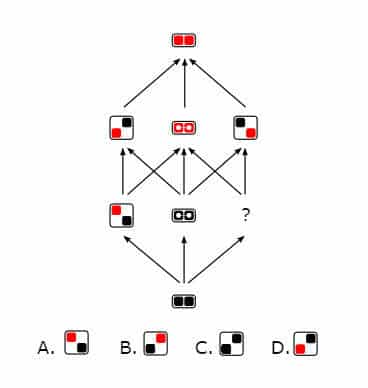Raven’s Standard Progressive Matrices (or Raven’s SPM) is a non-verbal intelligence test used to assess the test taker’s observational skills, problem-solving and overall ability to learn. Unlike other IQ tests that provide a wide range of intelligence scores from their subtests, Raven’s SPM produces a single raw score from the 60 items (i.e. questions/problems) presented in the test. The test’s 60 items are broken into 5 sets of 12 and do not include a time limit. The test is designed for use for children as young as 5 and can also be used with the elderly.
The Raven’s Matrices test was developed originally by John C. Raven in 1936. The multiple-choice items/questions are presented in an order of progressive difficulty and considering that many of the test’s patterns are presented in square matrices ranging from 6×6 to 2×2, the “Progressive Matrices” title was deemed appropriate.
A culturally inclusive IQ test
A common issue among intelligence tests is the inability to account for cultural differences. So, for example, an intelligence test that offers multiple choice questions that relate to historical knowledge might be unusually difficult for someone from a culture that doesn’t typically study that particular period or subject in history. Furthermore, the test is designed to avoid having a language bias, making it easier to assess the intelligence of people who may otherwise have to take an IQ test that’s not in their native language.
What the Raven’s Progressive Matrices Test Measures
This test is primarily geared toward gaining an understanding of the subject’s fluid intelligence and abstract reasoning through its 60 non-verbal questions. The test is easy to administer, so it has found many practical applications as it has been found to measure the two main components of Spearman’s g: the ability to think clearly and eductive ability (the ability to make sense of complexity).
An example of a matrix question can be seen below where the test taker would have to solve for the correct image to replace the question mark.

Practical Applications of the Raven’s Test
The test is perhaps most famous for its use in the British military. From 1942 onwards the British armed forces used a 20-minute version of the test as part of their entrance requirements. Officers took an adapted version of the test, and other militaries around the world picked up on it as well, as it has also been used in the Russian military. For non-military applications, certain high IQ societies have used the Raven’s Advanced Progressive Matrices test (more on that below) as an accepted IQ test for admittance, if the applicant can achieve a high enough score.
Variations of the Raven’s Tests
There are three common variations of the Raven’s Matrices, those being:
- Standard Progressive Matrices. This is the common form of the test in its original format, with 60 items in five sets (A to E) of 12. The items are progressively more difficult to understand, analyze and decode. The entire test is in black and white. A parallel version of this test was published in 1998, the Standard Progressive Matrices Plus, which had more difficult questions designed to increase the difficulty of the test as the general population was thought to have become too familiar with the standard questions.
- Colored Progressive Matrices. This version of the test is geared towards children between the ages of 5 and 11, as well as the elderly and people with mentally and physically impaired individuals. It includes sets A and B from the Standard Progressive Matrices but also includes a set that’s referred to as Ab. This test features most questions on a colored background to provide visual stimulation for the participants.
Advanced Progressive Matrices. Raven’s Advanced Progressive Matrices (APM) are split into two sets, Set I and Set II. The first set contains 12 items and the second contains 36. The items, like the Standard Progressive Matrices, become progressively more difficult and are presented in black and white. However, the APM test is geared towards adolescents and adults who are gifted or of above average intelligence.
